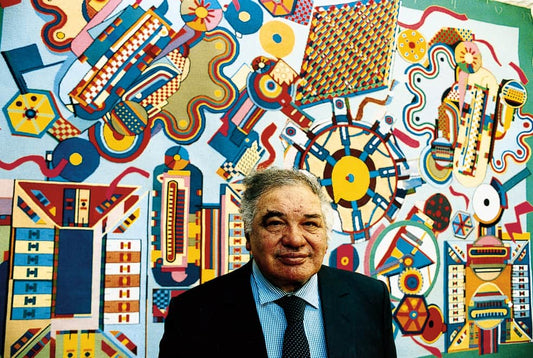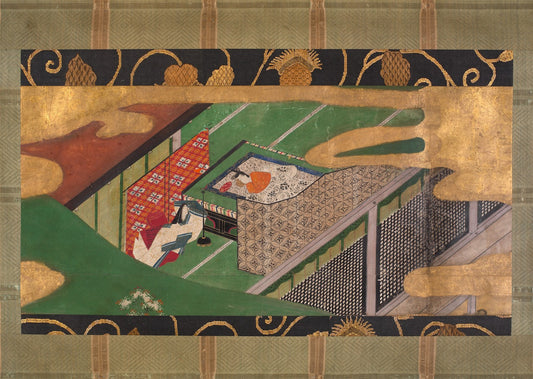Feature image: Julia Chiang, Spit Sweat Shhh, 2019 via Mutual Art (rotated)
Spit has enjoyed iconic moments in pop culture. From the popular game of spit takes to Rose spitting in the face of her abusive fiancé Cal, spit can be humorous, gratifying, and gross. Similarly, what would the Rocky movies be without sweat or “Avatar the Last Airbender” without Katara’s inventive sweat-bending? Although they are both unpleasant liquids, spit and sweat are present in our daily lives and in the media we consume. Artists have used these common and seemingly mundane liquids to create innovative works that push traditional portraiture boundaries, question ideas around graffiti, and reject visual art in favor of our other senses. This article will discuss a few examples of artists who have used spit or sweat to create their works.
Spit
James Castle (1931-1977)
James Castle was a prolific self-taught artist who was relatively unknown for the first 40 years of his life. Castle’s works were largely created on scraps of paper and cardboard that he found himself. He also created his own pigments by mixing stove soot with his saliva. Castle was born deaf, and while he did attend a school for the deaf and blind, he never became fluent in methods of communication such as sign language or lipreading. He communicated largely through his art and often depicted the rural landscape of Idaho, where he lived his whole life. His style of work has been compared to Vincent Van Gogh by the director of the Portland Art Museum. While Castle’s work is less colorful, his style does feel reminiscent of Van Gogh, particularly in Castle’s Potato Eaters and Bedroom in Arles. Castle’s self-taught style, primitive art materials, and deafness prompted important conversations in the art world, which possessed biases against artists who lacked formal training or who lived with disabilities. Spit played an important role in Castle’s art practice, particularly in his early years, and helped enable him to share his vision of the world through his own lens.
Albert Reyes (2006-2007)
Albert Reyes discovered spit art after he spilled his drink on the sidewalk. While looking down at the spill, he noticed that it resembled a chicken. Reyes realized that he could deliberately create such shapes using spit. He discovered that spit behaved like graffiti—but without the permanence of spray paint, as his images eventually dried and faded away. Reyes often performed his spit artworks on the sidewalk outside of his shows. He would kneel down with his face just a few inches above the ground, allowing his spit, combined with his favorite medium, white wine, to dribble onto the pavement. Reyes's spit art is full of movement as he adds details while allowing the traffic flow of people and cars to proceed. Reyes often creates one-line portraits of people or animals using his spit method, but he has also created drawings of famous individuals like Michael Jackson and Ronald McDonald.
Ines Camara Leret, Spit Crystal (2016)

Ines Camara Leret is fascinated by DNA, considering the genetic molecules to be “memories.” Leret has shared that she is interested in “taking something unseen and making it visible.” Her art deeply reflects this sentiment. Her work Spit Crystal, a crystal made from Leret’s saliva, took two months to complete. It was made possible through Leret’s work with the Science Gallery London, which helped her create her crystallization process. Leret has shared that she is interested in the differing cultural attitudes towards saliva. While spitting is viewed as rude and unhygienic in the West, indigenous populations in Peru use saliva to cook. In this culture, women chew on pieces of corn, spit them into a pot, and allow it to ferment. Once the fermentation process is done, it yields a corn-based beer called “chicha.” Leret decided to take something deemed disgusting by Western standards and turn it into something more visible and beautiful. The crystal itself was created from a month’s worth of Leret’s saliva, which she collected and kept refrigerated until it was mixed with salt and heated with a solution that allowed the crystallization process to occur as it cooled.
Justine Varga, Maternal Lines (2017)
Maternal Lines was created by Justine Varga and her grandmother. Varga had her grandmother scribble her likeness with pen, crayon, and her own spit on a piece of paper that Varga then transferred onto a piece of large-format film. Varga hand-printed the film onto photographic paper, creating an autobiographical portrait of her grandmother. The image subverts expectations of traditional portraiture, forgoing the classic image of a person's face in favor of their writing and DNA. The work won the Olive Cotton Award for Photographic Portraiture in 2017. This decision sparked controversy because the image was produced without a camera. In fact, the judge who picked the work, Dr Shaune Lakin, received aggressive hate mail for her decision. Varga hopes to expand photography’s capacities to record and memorialize. She is also interested in the transaction that occurs between the photographer and the subject. Of this work,
[My grandmother’s] not a young person or an elderly person. I’ve just captured her, and for me, when I look at that, I have a direct connection to my grandmother, the person rather than the exterior of the person.”
Sweat
Anicka Yi, Life Is Cheap (2017)
Life is Cheap explores “how assumptions and anxieties related to gender, race, and class shape physical perception.” The show contains multiple of Anicka Yi’s works, including Immigrant Caucus, a work that forgoes visual stimuli in favor of the viewer’s sense of smell. Immigrant Caucus is a scent created using sweat from Asian American women and ants. To create this scent, Yi worked alongside molecular biologists and forensic chemists. Yi has shared that this work specifically examines what she calls “a biopolitics of the senses.” Yi challenges perceptions of visual art by creating a space where smell, not sight, becomes the artwork. While intrigued by the concept, many found the scent to be largely forgettable and faint. The smell has been described as slightly bitter and acidic and was emitted through insecticide spray cans on the floor as audience members walked into the show.
Alice Potts, Perspire (2018-Present)
Alice Potts gained attention in 2018 when she first debuted her athleticwear, which featured sweat-grown crystals adorned throughout the garments. From baseball caps to a ballerina's pointe shoes, Potts has used her sweat crystal method to create stunning works. Of these works, Potts says, "Sweat has the power to show the beauty of how hard an individual works and the stories people tell." Potts submerged the clothes in a salt solution for over ten hours so the crystals could grow. The crystals varied in size, from large, chunky crystals to smaller, more jagged ones. They created a dynamic and visually intricate design woven throughout the sweaty cloth. The sweat crystals can last for years but eventually will fall off. Potts found a visual distinction between the crystals produced by men and women. While men's sweat produced crystals with flatter peaks, women's sweat created sharply pointed crystals. Potts has always wanted to transform her artwork into fashion pieces and hopes these series will challenge conventional notions of sweat.
There is an interesting split among these works. Castle and Reyes use spit in ways that could be easily replicated. The way these artists interact with these fluids can be seen as a universalizable act. Everyone can access their body fluids, regardless of education or status. In contrast, Leret, Yi, and Potts created their works in conjunction with chemists and scientists. Their works demand high levels of education and access to costly materials. Despite these differences, each has success and pushed boundaries. They stand as a reminder that art has no limits and beg questions about the possibilities spit and sweat still hold for this ever-expanding and creative community.
©ArtRKL™️ LLC 2021-2023. All rights reserved. This material may not be published, broadcast, rewritten or redistributed. ArtRKL™️ and its underscore design indicate trademarks of ArtRKL™️ LLC and its subsidiaries.








